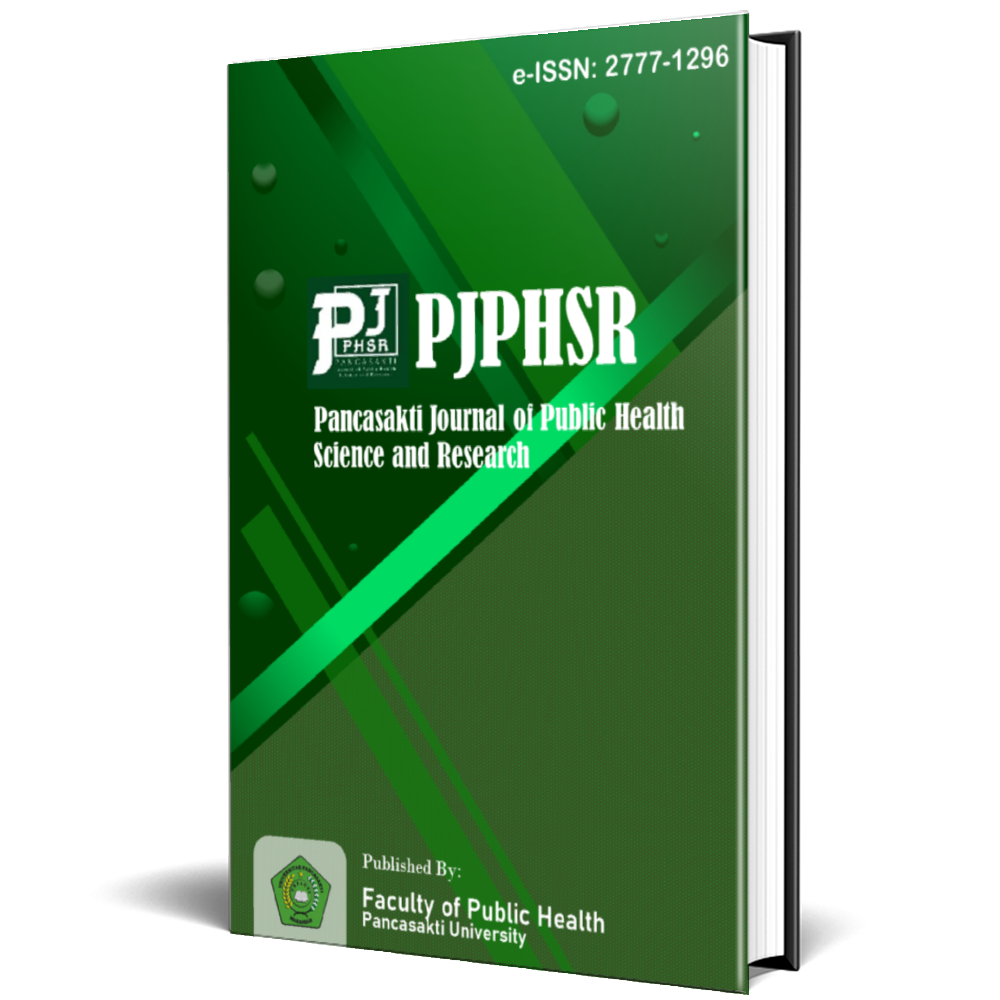Descriptive Study of Gadget Usage Patterns and Their Implications for Academic Performance and Health
Abstract
The widespread adoption of digital technologies among university students necessitates a thorough investigation into their usage patterns and the multifaceted implications for academic achievement and health. This study aims to provide a descriptive overview of gadget usage patterns among university students. This study utilizes a descriptive research design with a cross-sectional approach. A sample size of 77 students was selected using a consecutive sampling sampling technique. data collection was conducted using a questionnaire in the form of a Google form. This study found that the majority of respondents were female (53.2%), aged 18-23 years (54.5%), who used gadgets for 1-6 hours daily (53.2%). The most commonly used application was social media (27.3%). Smartphones and tablets were the gadgets used most frequently (57.1%), which the respondents kept near them while sleeping (41.6%). Within the home, the TV was located in the bedroom or near the bedroom (35.1%), and the respondents reported their emotional condition as normal (68.8%). Gadget usage among students is shaped by their characteristics and behavioral patterns in utilizing technology. Further research is needed to examine the implications of these usage patterns on students' academic achievement and well-being.
References
Amez, S. and Baert, S. (2020) ‘Smartphone use and academic performance: A literature review’, International Journal of Educational Research, 103, p. 101618. Available at: https://doi.org/https://doi.org/10.1016/j.ijer.2020.101618.
APJII (2024) Survei Internet APJII 2024, https://survei.apjii.or.id/.
de Barros, E.C. (2024) ‘Understanding the influence of digital technology on human cognitive functions: A narrative review’, IBRO Neuroscience Reports, 17, pp. 415–422. Available at: https://doi.org/10.1016/j.ibneur.2024.11.006.
Bayanova, A.R. et al. (2019) ‘Student Performance Interrelation with Gadget Use at Lessons’, Journal of Environmental Treatment Techniques, 7(3), pp. 432–437. Available at: http://www.jett.dormaj.com.
Fadhilah, I. and Lestari, P. (2022) ‘The Correlation Between the Duration to Use Social Media and Insomnia in Adolescents at Pagerwojo Village Limbangan Kendal’, Menara Jurnal of Health Science, 1(3), pp. 273–279. Available at: http://jurnal.iakmikudus.org/index.php/mjhs.
Feng, S. et al. (2019) ‘The Internet and Facebook Usage on Academic Distraction of College Students’, Computers & Education, 134, pp. 41–49. Available at: https://doi.org/https://doi.org/10.1016/j.compedu.2019.02.005.
Fu, S., Xiaoyu, C. and and Zheng, H. (2021) ‘Exploring an adverse impact of smartphone overuse on academic performance via health issues: a stimulus-organism-response perspective’, Behaviour & Information Technology, 40(7), pp. 663–675. Available at: https://doi.org/10.1080/0144929X.2020.1716848.
Huey, M. and Giguere, D. (2023) ‘The Impact of Smartphone Use on Course Comprehension and Psychological Well-Being in the College Classroom’, Innovative Higher Education, 48(3), pp. 527–537. Available at: https://doi.org/10.1007/s10755-022-09638-1.
Kassaw, C. and Demareva, V. (2023) ‘Determinants of academic achievement among higher education student found in low resource setting, A systematic review’, PLOS ONE, 18(11), p. e0294585. Available at: https://doi.org/10.1371/journal.pone.0294585.
Kolhar, M., Kazi, R.N.A. and Alameen, A. (2021) ‘Effect of social media use on learning, social interactions, and sleep duration among university students’, Saudi Journal of Biological Sciences, 28(4), pp. 2216–2222. Available at: https://doi.org/https://doi.org/10.1016/j.sjbs.2021.01.010.
Kurmanova, A. et al. (2022) ‘University students’ relationship with technology: Psychological effects on students’, World Journal on Educational Technology: Current Issues, 14(4), pp. 1225–1233. Available at: https://doi.org/10.18844/wjet.v14i4.7743.
Limniou, M. (2021) ‘The Effect of Digital Device Usage on Student Academic Performance: A Case Study’, Education Sciences, 11(3). Available at: https://doi.org/10.3390/educsci11030121.
Madarcos, C.A., De Vera, M.G. and Manlavi, M. (2024) ‘The Effectiveness of Using Gadgets on Students’ Learning Interests and Academic Performance’, International Journal of Education and Teaching Zone, 3(1), pp. 1–11. Available at: https://doi.org/10.57092/ijetz.v3i1.222.
Nakshine, V.S. et al. (2022) ‘Increased screen time as a cause of declining physical, psychological health, and sleep patterns: a literary review’, Cureus, 14(10).
Nurfadhilah, N. and Muqoddasah, W. (2024) ‘Determinan Adiksi Media Sosial pada Mahasiswa Fakultas Kesehatan Masyarakat Universitas Muhamadiyah Jakarta’, Jurnal Semesta Sehat (J-Mestahat), 4(1), pp. 32–40. Available at: https://doi.org/10.58185/j-mestahat.v4i1.118.
Perez Algorta, G. et al. (2018) ‘Blue blocking glasses worn at night in first year higher education students with sleep complaints: a feasibility study’, Pilot and Feasibility Studies, 4(1), p. 166. Available at: https://doi.org/10.1186/s40814-018-0360-y.
Putra Wijaya, R. et al. (2023) ‘Pengaruh Dampak Dari Gadget Yang Mempengaruhi Kurangnya Minat Baca, Minat Belajar Terhadap Mahasiswa Gen Z’, Inovasi dan Kreativitas dalam Ekonomi, 8(1), pp. 226–241. Available at: https://oaj.jurnalhst.com/index.php/ike/article/view/8777/9885 (Accessed: 9 April 2025).
Rafique, N. et al. (2020) ‘
Effects of Mobile Use on Subjective Sleep Quality
’, Nature and Science of Sleep, Volume 12, pp. 357–364. Available at: https://doi.org/10.2147/NSS.S253375.Sapci, O. et al. (2021) ‘The relationship between smartphone use and students` academic performance’, Learning and Individual Differences, 89, p. 102035. Available at: https://doi.org/https://doi.org/10.1016/j.lindif.2021.102035.
Surat, S. et al. (2021) ‘An Educational Study on Gadget Addiction and Mental Health among Gen Z’, Creative Education, 12(07), pp. 1469–1484. Available at: https://doi.org/10.4236/ce.2021.127112.
Takeuchi, H. et al. (2018) ‘Impact of frequency of internet use on development of brain structures and verbal intelligence: Longitudinal analyses’, Human Brain Mapping, 39(11), pp. 4471–4479. Available at: https://doi.org/10.1002/hbm.24286.
Thomas, N.M. et al. (2022) ‘“Digital Wellbeing”: The need of the hour in today’s digitalized and technology driven world!’, Cureus, 14(8).
Varghese, S., Shaji, Dr.N.M. and Joshi, Dr.H. (2022) ‘A Web Grounded Check on Impact of Inordinate Operation of Electronic Gadgets on the Mental, Social and Physical Exertion of College Scholars’, International Journal of Pharmaceutical Sciences Review and Research, pp. 8–11. Available at: https://doi.org/10.47583/ijpsrr.2022.v73i01.002.
Wibowo, D.C. et al. (2020) ‘Description Of Gadget Addiction, Sleep Quality, And Students Learning Achievement at SD Negeri 1 Sidodadi Lawang in 2019’, Journal of Community Medicine and Public Health Research, 1(2), pp. 72–78. Available at: https://doi.org/10.20473/jcmphr.v1i2.21698.
Zulkarnain, M.E., Atul, I.’ and Erfantinni, H. (2025) ‘Tingkat Penggunaan Gadget Pada Mahasiswa Selama Masa Pandemi’, Journal of Islamic Counseling, 1(1), pp. 83–98. Available at: http://yambus-lpksa.com/index.php/MIZAJ/index.
Copyright (c) 2025 Nur Inayah Rauf, Irwan Irwan, Anna Maria Daud, Anggun Dinianti

This work is licensed under a Creative Commons Attribution-NonCommercial-ShareAlike 4.0 International License.








